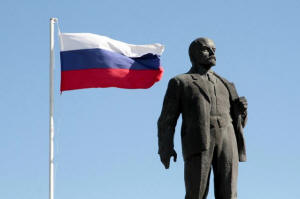|
Lenin was born in 1870 and became one of the 20th century's most
important leaders as the revolution inspired by Karl Marx
transformed Russia and influenced Socialists around the world
for decades.
As the first leader of the one-party communist state, Lenin
redistributed land and nationalized industry and banks in a bid
to champion the working class. He also used violence on a wide
scale to crush perceived opponents of his Marxist ideology.
When he died in 1924, Soviet authorities displayed his body in a
mausoleum in Moscow's Red Square where it lies to this day.
They also built monuments and statues of him around the Soviet
Union, often depicting him giving a speech to supporters at a
station in what is now Saint Petersburg on his arrival from
exile by train in April 1917 to lead the revolution.
For the photo essay on monuments of Lenin click on:
http://reut.rs/2h411d4
Many of the memorials have been toppled or removed since the
Soviet Union was dissolved in 1991 but others remain, reflecting
a debate in Russia about his legacy.
(Writing by Matthew Mpoke Bigg; Editing by Gareth Jones)
[© 2017 Thomson Reuters. All rights
reserved.] Copyright 2017 Reuters. All rights reserved. This material may not be published,
broadcast, rewritten or redistributed.

|






